Irish Terrier
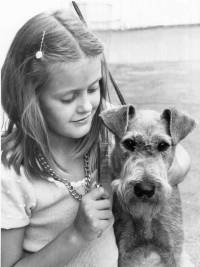 Irish Terrier
Irish Terrier
Make room in your heart for the perfect dog - the Irish Terrier! These jaunty debonair daredevils have a deep affection for their master and family and their owners are well rewarded by these intelligent animals' responsiveness and personality. Previously known as 'the Dare Devil', the Irish Terrier has a mind of his own especially when he sees a strange cat, rabbit or potential canine adversary!
Such is the description from a breeder whose Irish Terriers dominated her life[1].
History of the Irish Terrier
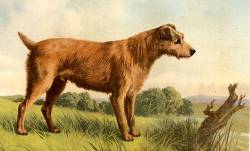 Irish Terrier 1879
Irish Terrier 1879
From 1500 AD, Ireland became increasingly populated by peasant farmers, each of whom had a small plot of badly fenced land. By the 1800's potatoes had become their staple diet and families spent their nights gathered around the fire, waiting for their 'murphies' to cook.
 Irish Terrier c 1900
Irish Terrier c 1900
Completing this average family circle was a watch dog which chased away pigs or other animals from neighbouring farms and killed rats either out of necessity or for the sport of ratting. During the day, these dogs were general farm dogs which were often allowed to lay by the fire. But at night they had to patrol the property and when off duty, had nowhere else to curl up and sleep but in a ditch.[2]
As these terriers effectively ran wild, they were randomly bred. For centuries the hardiest dogs with the most pluck and endurance had the biggest influence on the breed. Hence generations of this life made the Irish Terrier the hardy, robust dog he is today. However, as their background of hardship gave them the temperament which made them famous, should always be respected.
Ireland was run as a colony of Great Britain with only wealthy landowners eligible to be their elected representatives. Tenant farmers who were mainly Irish Catholics, were prohibited from owning land.
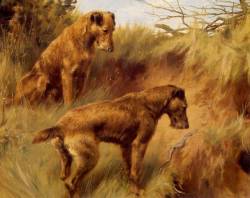 Irish Terriers c 1900
Irish Terriers c 1900
When the potato famine began in 1845, the poor tenant farmers were forced to pay exorbitant rent to the wealthy landowners. To exacerbate matters, England put such a high tariff on grain, alternative foods like corn and bread then became prohibitively expensive. As the dogs' as well as their peasant owners' staple diet was potatoes, more than 1,000,000 people died from starvation. Additionally, more than a million others migrated to other countries to escape the dreadful conditions back home. Of these, many came to Australia accompanied by their beloved Irish Terriers.
The Irish Terrier become a Pure Breed
 Irish Terrier
Irish Terrier
As well as the peasants, wealthy land owners who also kept Irish Terriers entered them in early dog shows held elsewhere in in Britain. Consequently, the first record of an Irish Terrier entered in a dog show was in Glasgow (Scotland) in 1875. In 1876, classes were available in Brighton (England). In 1879, a bitch named 'Erin' from Belfast (Ireland) made her appearance at Alexander Palace (London) in 1879. She and a dog named 'Killiney Boy' are considered to be the founders of the breed[5].
Also in 1879, the first Club to cater specifically for Irish Terriers was established in Dublin by Dr Richard Carey. He and his colleagues drew up a standard description and a standard of points for the breed. Then, an English section of the same Club was set up in London by Englishman, Mr George R Krehl who also wrote the first official breed description and set up the first list of judges. This made the Irish Terrier the first native Irish breed to be appear in the English Kennel Club Stud Book[6]
History of Irish Terriers in Australia
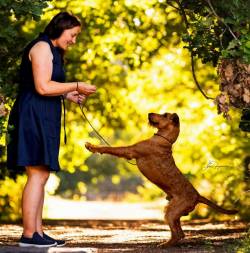 Irish Terrier
Irish Terrier
When more than 1,000,000 Irish people migrating to other countries to escape the dreadful conditions back home, many came to Australia accompanied by their beloved Irish Terriers. Australia was a particularly attractive destination when gold was discovered in 1851, with 100,000 people arriving in Victoria alone in the next 3 years.
By 1912, 48 Irish Terriers were recorded as being imported, another 57 formally registered[3]. As Australia had no formal registration system in place to record pedigrees until 1912, probably there were lots more Irish Terriers that were indiscriminately bred. But popular they were, the Victorian Irish Terrier Club being formed in 1894 separately to the Victoria Terrier Club which was formed in the same year[3b].
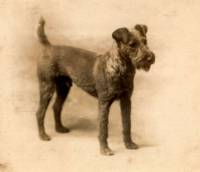 Irish Terrier c 1913
Irish Terrier c 1913
The Irish Terrier 1913 pictured on the left, was photographed in Ballarat, was Ch Crow Gill Muddler (Imp UK) who won Best Exhibit in Show at the Ladies' Kennel Club Show in 1911[3] as well as Best of Breed at the Ballarat Kennel Club in 1913. He came from a family of highly priced English bred Irish Terriers demonstrating just how extremely popular they were in Australia in those early years. It is on record that a Show held In 1914 in Victoria conducted by the 'Fox and Irish Terrier Club' drew 400 entries, with another Club, 'the Airedale and Irish Terrier Club' also active in NSW at that time[4].
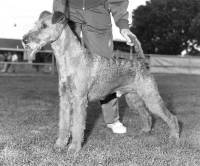 Irish Terrier c 1970
Irish Terrier c 1970
During the Second World War, activity with many breeds including the Irish Terrier almost ceased. However, by the late 1940's some of the old stalwarts began renewing their passion with a new wave of impressive imports arriving from UK, one of which won Reserve Best in Show at Sydney Royal in 1964.
In true Aussie spirit, our Australian Dog World has been kept alive by many one-eyed passionate breeders and exhibitors, many of whom have never judged a dog show or become what we call today, 'high profile'. Their legacy remains in the form of the Irish Terrier to which they devoted so much of their lives.
The Irish Terrier Today
 Irish Terrier
Irish Terrier
The Irish Terrier is a whole coloured red, red wheaten or yellow-red dog without black shading, standing 46 - 48 cm (18 - 19 inches) tall. He should always be good tempered and alert, displaying evidence of the instinctive pluck embedded in his temperament that has endeared him to enthusiasts for the past century, as a pet, watch dog and pure breed.
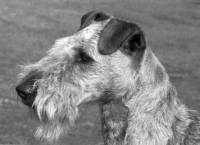 Irish Terrier (Female)
Irish Terrier (Female)
The Irish Terrier has a racy but graceful outline, but never cobby. In balance with this overall racy outline, the Irish Terrier has a long and rather narrow head with a flat skull, clean cheeks and a slight but perceptible stop. His long strong foreface or muzzle and almost black tight-fitting lips house a normal scissors bite. His nose should always be black and his small dark eyes and small moderately thin V-shaped high set neat ears that drop forward close to the cheek to complete his alert expression.
 Irish Terrier
Irish Terrier
In keeping with the Irish Terrier's racy outline, his neck is fairly long without loose skin or dewlap, running smoothly into the smooth topline created by his well laid back shoulders and muscular strong slightly arched loin. Built with the same basic construction of the long legged terriers, his body is moderately long, his back strong and straight and his chest and ribs deep but not round or wide, so accommodating his terrier front with the elbows working clear of the sides when the dog is either moving or digging. He moves with balanced reach and drive.
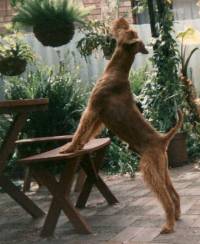 Irish Terrier
Irish Terrier
His muscular forelegs are perfectly straight with upright pasterns running into small round feet, preferably with black nails but always with strong pads with never a sign of cracks or imperfections like warts. His hindquarters are also strong and muscular. His high set tail is carried gaily and should be of a thickness to complete the general overall balance of the dog.
The Irish Terrier has a double, or broken coat. His harsh wiry top coat lies flat and is free of silkiness, curl and fringe should never obscure the overall racy outline of the dog. However, as the coat is still a double coat, there is some soft undercoat at the base of the stiff hairs that form the top coat. Although his ears and tail are free of fringe, unusually there is a slight fringe of hair running up the sides of his neck to the corner of his ears.
BREAKING NEWS.
We have now published a unique Terrier book 'Terriers Unveiled' Available at our sister site: https://rangeairevision.com/terriers-unveiled/
References and Further Reading
Published as - 2019 - Jane Harvey, "Irish Terriers in Australian History" in Dog News Australia (Top Dog Media Pty Ltd Austral NSW) June 2019, Page 8
[1] Betty Gerdsen, 'The History of Purebred Dogs in Australia' The Irish Terrier published by OzDog Newspaper 1997 Page 185
[2] Mr W J Cotten in Rawdon B. Lee's, "Modern Dogs" of Great Britain and Ireland (Third Edition) London:Horace Cox, "Field" Office, Windsor House, Bream's Buildings, E.C. 1903 Chapter IX, Pages 227 - 229
[3] T.W.Tyzack and C.S. Turner "Tyzack's Annual" published by the Victorian Poultry and Kennel Club 1912, printed by Bellmaine Bros., Printers 66 - 70 Flinders Lane Melbourne Australia Page 68 (Advertisement)
[3a] Ibid., Pages 71 - 75 (Stud Book) and Pages 96 - 97 (Importations)
[3b] Ibid., A separate Victorian Irish Terrier Clubs were formed 1894 Page 132.
[4] Mary Connolly, "The British Terrier Club of NSW Diamond Jubilee Handbook 1907 - 1967" published by Hi-Line Press Pages 105 - 108
[5] Edna Howard Jones, 'The Irish Terrier' Published by W & G Foyle Ltd 119 - 125 Charing Cross Road, London W.C.2 Chapter One "History' Page 15
[6] The Kennel Club of Ireland 'The Native Dogs of Ireland' published by The Irish Kennel Club Dublin, Ireland 1984 'The Irish Terrier Page 64
See also Jane Harvey, DVD "Terriers Then & Now" (Rangeaire Vision 2002, 2004) ISBN 978-0-9804296-4-0